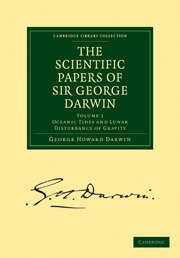Book contents
- Frontmatter
- PREFACE
- Contents
- Chronological List of Papers with References to the Volumes in which they probably will be contained
- PART I OCEANIC TIDES
- ART. 1 The Harmonic Analysis of Tidal Observations
- ART. 2 On the Periods Chosen for Harmonic Analysis, and a Comparison with the Older Methods by means of Hour-angles and Declinations
- ART. 3 Datum Levels: the Treatment of a Short Series of Tidal Observations and on Tidal Prediction
- ART. 4 A General Article on the Tides
- ART. 5 On the Harmonic Analysis of Tidal Observations of High and Low Water
- ART. 6 On an Apparatus for Facilitating the Reduction of Tidal Observations
- ART. 7 On Tidal Prediction
- ART. 8 On the Correction to the Equilibrium Theory of Tides for the Continents
- ART. 9 Attempted Evaluation of the Rigidity of the Earth from the Tides of Long Period
- ART. 10 Dynamical Theory of the Tides
- ART. 11 On the Dynamical Theory of the Tides of Long Period
- ART. 12 On the Antarctic Tidal Observations of the ‘Discovery’
- PART II THE LUNAR DISTURBANCE OF GRAVITY
- INDEX
- Plate section
ART. 4 - A General Article on the Tides
Published online by Cambridge University Press: 07 September 2010
- Frontmatter
- PREFACE
- Contents
- Chronological List of Papers with References to the Volumes in which they probably will be contained
- PART I OCEANIC TIDES
- ART. 1 The Harmonic Analysis of Tidal Observations
- ART. 2 On the Periods Chosen for Harmonic Analysis, and a Comparison with the Older Methods by means of Hour-angles and Declinations
- ART. 3 Datum Levels: the Treatment of a Short Series of Tidal Observations and on Tidal Prediction
- ART. 4 A General Article on the Tides
- ART. 5 On the Harmonic Analysis of Tidal Observations of High and Low Water
- ART. 6 On an Apparatus for Facilitating the Reduction of Tidal Observations
- ART. 7 On Tidal Prediction
- ART. 8 On the Correction to the Equilibrium Theory of Tides for the Continents
- ART. 9 Attempted Evaluation of the Rigidity of the Earth from the Tides of Long Period
- ART. 10 Dynamical Theory of the Tides
- ART. 11 On the Dynamical Theory of the Tides of Long Period
- ART. 12 On the Antarctic Tidal Observations of the ‘Discovery’
- PART II THE LUNAR DISTURBANCE OF GRAVITY
- INDEX
- Plate section
Summary
Introduction.
The object of the present article is to show how the best use may be made, for scientific purposes, of a short visit to any port.
We refer to the article “Hydrography” [Admiralty Scientific Manual] for an account of the method of observing the tides, and shall here assume that the height of the water above some zero mark may be measured, in feet and decimals of a foot, at any time, and that the zero of the tide gauge may be referred by levelling to a bench-mark ashore.
Something of the law of the tide might be discovered from hourly or half-hourly observations even through a single day and night, but to discover the law at all adequately it is necessary that the observations should embrace at least one spring tide and one neap tide. For the full use of the methods given below, the observations should be taken each hour for 360 hours, or 720 hours. A longer series must be regarded as a new set of observations, and the means must be taken of the results of the several sets.
It has been usual to recommend observations of the times and heights of high and low water, but hourly observations are far preferable, the hours being reckoned according to mean time of the port.
We shall, however, begin by a sketch of the treatment of observations of high and low water, and shall then give more detailed instructions for hourly observations and the formation of a tide table.
- Type
- Chapter
- Information
- The Scientific Papers of Sir George DarwinOceanic Tides and Lunar Disturbance of Gravity, pp. 119 - 156Publisher: Cambridge University PressPrint publication year: 2009First published in: 1907



